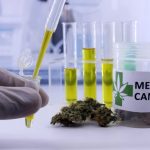Density and Solubility – It’s All About Pressure and Temperature
Solubility is one of the most important parameters in the CO2 supercritical fluid extraction process while density is the key to the solubility of the individual components. By modifying the pressure and temperature of the CO2 system, the solubility properties of the solvent can be adjusted, thereby enabling a selective extraction of cannabinoids and terpenes as each compound reacts differently and has a different degree of solubility to the operating conditions. So, what temperature and pressure parameters are going to provide the optimum density for efficient mass transfer? Let’s look at an example.
Let’s say my system is at 40°C, and I increase the pressure; what happens is that the CO2 density increases. If I am at a steady pressure of 200 bar and I increase the temperature, the density decreases. Why would I increase the temperature if there is less density? Good question ̶ it’s a balancing act to obtain the optimum density for the CO2 and the temperature that will make the material more amenable to be extracted while maintaining the optimum pressure to draw the compounds off.
Perrotin-Brunel et al.1 performed a study to determine the optimum pressure and temperature ranges to extract CBD, CBG, CBN, and Δ9-THC selectively. At a constant temperature and pressure, the solubility of the compounds was different, indicating that it would be possible to get extracts with different cannabinoid amounts at different conditions. They further went on to determine the optimum temperature and pressure parameters to extract each compound.
What are the specific effects of pressure and temperature on the extraction? According to a publication by Supercritical Fluid Technologies2:
- decreases terpenoid concentration in the extract,
- risks possible denaturing of the product, and
- increases wax/resin extraction (thereby increasing extract quantity).
- increases the oil proportion of the extract, and
- reduces the wax proportion of the extract.
- From the initial chosen extraction pressure, increasing pressure increases wax/resin concentration in the extract
- Pressure over 5000 psi at 45°C causes chlorophyll extraction
- Increasing pressure increases chlorophyll in the extract
- Increasing temperature increases chlorophyll in the extract
- Higher pressures are harder to maintain if CO2 supply is not continuous (cylinders instead of bulk)
Ultimately, when designing the extraction methodology, there will be a tradeoff between product quality vs. quantity, process time vs. yield, and overall production cost.





